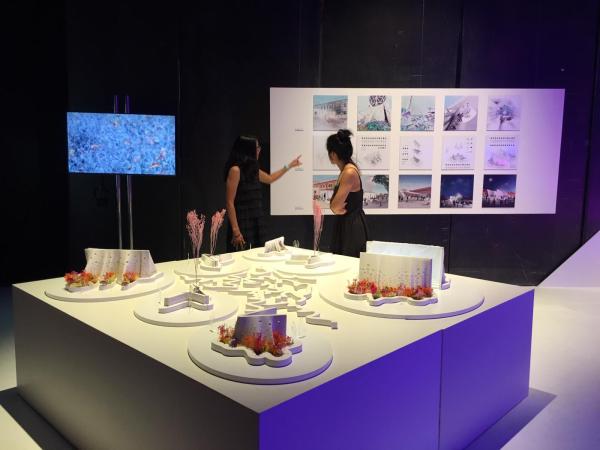Hidden in Plain Sight on display in Madrid until October 6th

Interior Design Assistant Professor Nerea Feliz has joined an international group of designers to explore how design can create a new discourse on climate change in the context of public space. Her project, Hidden in Plain Sight, is a proposal for a series of urban furnishings that aim to amplify and bring awareness to various forms or urban "life" and supports an inclusive web of interdependent species, both human and non-human.
Hidden in Plain Sight is part of a multi-year initiative to design a coral "Cyborg Garden" intended to turn the outdoor spaces of Matadero Madrid – a former slaughterhouse that has been converted into an arts center – into a laboratory for testing solutions for making the complex more habitable in the face of global climate change. Directed by Matadero Madrid and curated by Matadero Mutant Action and elii [architecture office], the initiative seeks to frame global planetary changes as a challenge that is as much cultural and political, as scientific and technological. Hidden in Plain Sight is one of five proposals for the "Cyborg Garden" that, together with the Eco-visionaries exhibition, is currently on view at Matadero Madrid until October 6th.
The project was developed in partnership with Joyce Hwang (Associate Professor and Associate Chair of the School of Architecture and Planning at the University of Buffalo), with Hwang and Feliz working together under the name "Double Happiness." During the design process, the team participated in a series of monthly interdisciplinary workshops with representatives from the Madrid City Council, Matadero Madrid, as well as scientists and experts from ITD-Universidad Politecnica de Madrid. At The University of Texas at Austin, students Robert Anderson, Hailey Brown, Raymond Castro, Richard Gagle, Gabriel Gatica, and Francisco Resendiz Carrill collaborated on the production of the exhibition drawings.
About the Project:
Hidden in Plain Sight aims to enhance our experience of public place. It is conceived of a series of urban furnishing prototypes that bring shading, lighting, vegetation, and seating into the public sphere. This family of prototypes operates between and across scales – from the scale of humans to the scale of the insect. A series of urban rooms, walls, and furniture pieces can function as individual units or in aggregation, setting the stage for public programming such as film screening and small concerts. Borrowing from models of interior occupation – not streets but corridors, not squares but rooms – Hidden in Plain Sight introduces a sense of public interiority and cultivates urban intimacy between the environment and the life forms that inhabit it.
Multi-species inhabitation
The project seeks to make visible the under-acknowledged world of non-human species – particularly insects – as active participants of urban life by attracting and magnifying their presence in our shared urban spaces. While we often think of cities as human-centered territory, insects are a significant part of our ecosystem, serving as pollinators, seed dispersers, decomposers, and as a food source for other species such as bats and birds. Various insect species are also bioindicators, or "living barometers" of environmental conditions. To support and cultivate beneficial insect populations, the project team identified some of the most common butterflies and moth species in the Casa de Campo and Madrid Rio area. The Hidden in Plain Sight prototypes incorporate planting scenarios to accommodate both caterpillars and butterflies as well, with mesh-enclosed planters protecting caterpillars from predators, while open planting beds house brightly colored wildflowers for nectar-seeking butterflies.
Mutualism in the urban environment
Hidden in Plain Sight deploys visual tactics to enhance insect habitability, while also provoking human curiosity through new spatial and perceptual experiences. Stemming from the fascinating world of insect vision and perception, the project uses colors, patterns, and light toward both insect and human benefit. To provide a sense of camouflage for butterflies, patterns are imprinted on the prototypes’ curving walls, evoking the double-sidedness of butterfly wings, and color-coordinating with adjacent wildflowers. To promote habitability by birds, bats, bees, and other insects, distinct ‘pods’ are fabricated and inserted into the upper portions of the prototype walls, adding a textural and volumetric dimension to the prototypes’ undulating surfaces. At night, the design uses “positive phototaxis” and ultraviolet black light to attract insects, a phenomenon that can be video-recorded and projected as a form of spectacle.
Project Assistants:
Robert Anderson, Hailey Brown, Raymond Castro, Richard Gagle, Gabriel Gatica, Francisco Resendiz Carrill, (The University of Texas at Austin). Sara Svisco, Zach Fields, Sasson Rafailov (University at Buffalo, State University of New York)
Video: Butterfly Vision
Director: Don Swaynos, Music: Curtis Heath, Camera: Paul Toohey
Video: Night Insects
Acknowledgement of source material: Michael Gitlin, Filmmaker, Film and Media Department, Hunter College. Source material taken from Gitlin’s set up to attract moths to lights at MacDowell Colony, 2016
Ecology Consultants:
Rafael Ruiz López de la Cova, Departamento de Cambio Climático, D.G. Sostenibilidad y Control Ambiental, Área de Medio Ambiente y Movilidad. Ayuntamiento de Madrid
Francisco Jose Cabrero, Biodiversidad, Ecología y Evolución, Facultad de Biología, Universidad Complutense de Madrid
Dr. José I. Aguirre, Biodiversidad, Ecología y Evolución, Facultad de Biología, Universidad Complutense de Madrid. José Luis Yela García, Profesor Titular de Zoología y Conservación Biológica, Universidad de Castilla-La Mancha

